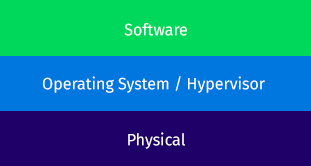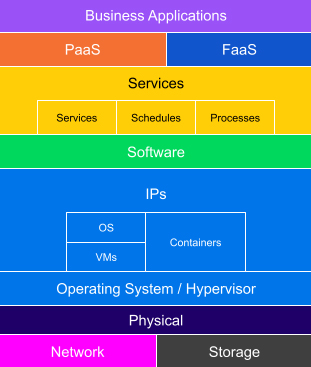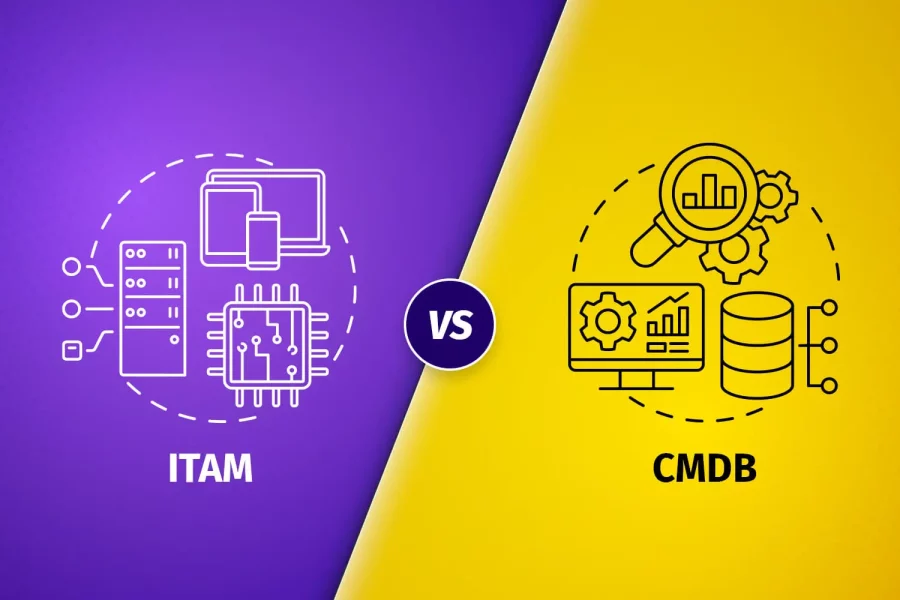In order to understand the differences and similarities, and their delivered value to a business between IT Asset Management (ITAM) and Configuration Management Database (CMDB), we should define each first:
ITAM intends to provide an account of technology asset lifecycle costs and risks to maximize the business value of the technology, and make contractual and sourcing decisions easier based on financial benefits. Therefore, ITAM products provide an inventory of all software and hardware found in the business environment including purchase dates and prices, license details, and serial numbers.
CMDB is a repository used to store the data of an entire IT environment and its relationships. Think of a CMDB as a filing system for all of the important IT assets or configuration items (CI’s). The CMDB is a centralized repository containing the entire IT infrastructure and it enables organizations to monitor, track and manage all of that infrastructure in one central place. Because of this, CMDBs are extremely helpful in making important business decisions, because they are able to show relationships between assets. The modern CMDB came from the natural evolution of ITAM systems, capturing data and details that go beyond financials.
The challenge for most enterprise organizations continues to be that they don’t know what they have, where all the technologies reside, and how they are all connected and interdependent. A good and accurate ITAM will solve the problem of letting them know what they have, but it fails to deliver on the interconnectivity and relationships of the resources.
Example of resources pulled into each repository:
| ITAM | CMDB | |
|---|---|---|
| Software Inventory Information | X | X |
| Hardware Inventory Information | X | X |
| Operating Systems / Hypervisor Information | X | X |
| Licensing Information | X | X |
| IP and MAC Address Info (IPAM) | X | |
| Subnet & Other Network Details | X | |
| Device relationship data | X | |
| Application Dependency / Relationship Mapping & Information (ADM) | X |
If you have a modern CMDB it will automatically consolidate and aggregate IT data, and you have all of the data and much more in one place. A modern CMDB knows about all your physical, virtual, and cloud devices, how they’re networked together, what applications, software, and services are running on each device, their inter-dependencies, and their interrelationships. Oddly enough, you also probably spent a lot less time getting all that data into the CMDB than you did getting the lesser amount of data into the ITAM system. See the comparison matrix and diagram below, which serves to demonstrate some of the larger differences between data found within a modern CMDB & and that in an ITAM solution.
| ITAM | CMDB |
|---|---|
 |  |
As you can see in the diagram above, ITAM is tracking hardware and software assets, and CMDB goes further and has a lot more information including the relationship between different assets and configurations of that asset at that time.
Assets and Configuration Items are different. An asset is generally an item with a financial value that has a lifecycle that has to be procured and disposed of. A configuration item is something that is configurable and is used in the delivery of a service. Sometimes, there’s a direct relationship, like with a workstation. It’s an asset with a defined lifecycle and financial value, and it’s used in the delivery of a service, so it’s a CI. Even so, it’s actually an Asset and a CI both rather than the terms being synonymous. Why? A Dell Inspiron will always be a Dell Insipron from the day you order it to the day it’s disposed of. During that time, it could actually be multiple different CIs….a Windows 10 End-user machine, a Linux Developer machine, etc, which are all entirely different configurations.
A modern CMDB continuously auto-discovers changes in your data center, including the details of the underlying networks, and connects that data to determine interdependencies. IP and MAC addresses in use by the hardware systems recorded within them are typically beyond the scope of ITAM systems, which are populated manually. Some can report the number of licenses for a given piece of software owned by the company but very few ITAM systems can tell you which machines actively utilize each software title. Furthermore, while an ITAM system might give you license details, a CMDB will know version information, patch levels and whether or not any software you are running has unpatched security vulnerabilities.
Because a CMDB holds a complete, detailed data set, other systems can integrate with and rely on the CMDB as a “source of truth” about the infrastructure. For example, IT Service Management (ITSM) systems can pull data from the CMDB on devices their issues reference, while automation tools can, again for example, request the next available IP address on a given subnet to auto-deploy new instances. When troubleshooting an issue, an ITAM system’s inventory data provides little value. In contrast, a CMDB dependency map could prove very useful in uncovering possible failures of the system in question. A comparison of some of the benefits this detailed data set provides to the modern CMDB over a typical ITAM system can be seen below, with the assumption that the ITAM data has been fully populated and correct, which in itself can be daunting and difficult to do.
| ITAM | CMDB | |
|---|---|---|
| Reduce Internal Audit Time | X | X |
| Improved Inventory Management Efficiency | X | X |
| Reporting for compliance mandates, such as PCI DSS, SOX, ISO 27001, HIPAA, and others | Minimum, but doesn’t include flow diagrams which need dependency data | X |
| Lifecycle Management – Ensuring maximum value from hardware | X | X |
| Reduced Troubleshooting Times & Improve MTTR (Mean-Time-To-Resolution) | X | |
| Improved business decisions based on richer context within the data set | X | |
| Driving Automation – Allow staff to focus on other, more specialized tasks. | X | |
| Capacity planning based on utilization | X |
A Comparison of Two Companies on the Same Mission
Let’s make the same point with an example of 2 companies. In a large enterprise, you’ll have many interdependencies between assets, CIs and applications. For instance, an application may be dependent on many databases, multiple servers (for HA), network switches, load balancers, and other application systems. In turn, other applications may be dependent on it as well. It may even go down to application components, if they’re important or impactful enough.
In addition to that, you have business owners, with SLAs for each connected system. And impacted users/customers as well.
Company A has a strong ITAM system – it knows what it has, and it stops there. Let’s say an engineer gets paged at 2 AM about a system being down. They will have to spend an enormous amount of time figuring out relations, dependencies, impacted users, vendors to call even with the hardware and software asset data.
Company B has a working CMDB system – it knows what it has, where it is and how it is all connected. In the same scenario as above when the engineer gets paged at 2 AM, they will save a lot of time (20% to 80%) orienting themselves to all the interdependencies, SLAs, impacted users and vendors, and be able to solve the problem much faster.
Evaluating Both ITAM and CMDB- The Most Important Factors to Consider When Choosing Between the Two Systems
So, what should you do next? If you are living in spreadsheets and manually keeping track of all of your assets – at least start with an ITAM tool, so you can automate the discovery process. But if you have SLAs, change management processes, and want to respond faster to outages and be more proactive to prevent outages you should strongly consider a modern CMDB, like Device42.
At Device42, we consider our technology a sort of ‘next generation’ CMDB. Device42, not only provides the full discovery and the relationships of the assets, but also includes insights where we take all that information including things like rack layouts, power consumption, workload utilization, cloud resources, and much more, to deliver insights in the form or dashboards and reports, about the vast data and relationships collected.
Conclusion: Why You Should Be Leveraging CMDB for Your Business
Ultimately, in order to deliver value to your business based on the tasks IT teams conduct every day anyway, from an operational perspective, it is imperative that you know the dependencies within your IT infrastructure, along with the knowledge of the IT resources, business relationships, ownership, vendor etc. A CMDB is the best solution for running IT with more confidence based on information it can provide. Use the Device42 complimentary CMDB Best Practices Guides to learn more about the CMDB.




